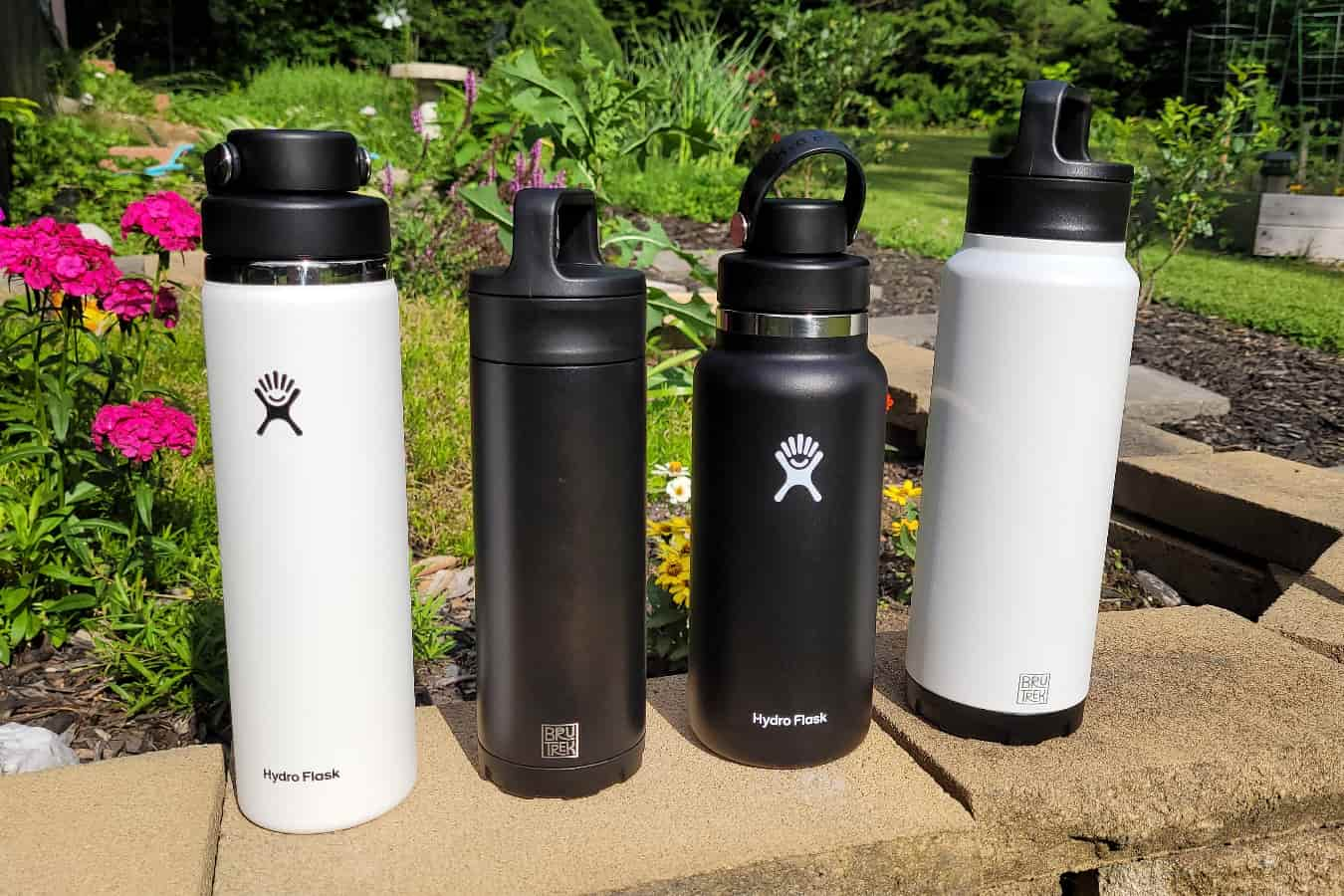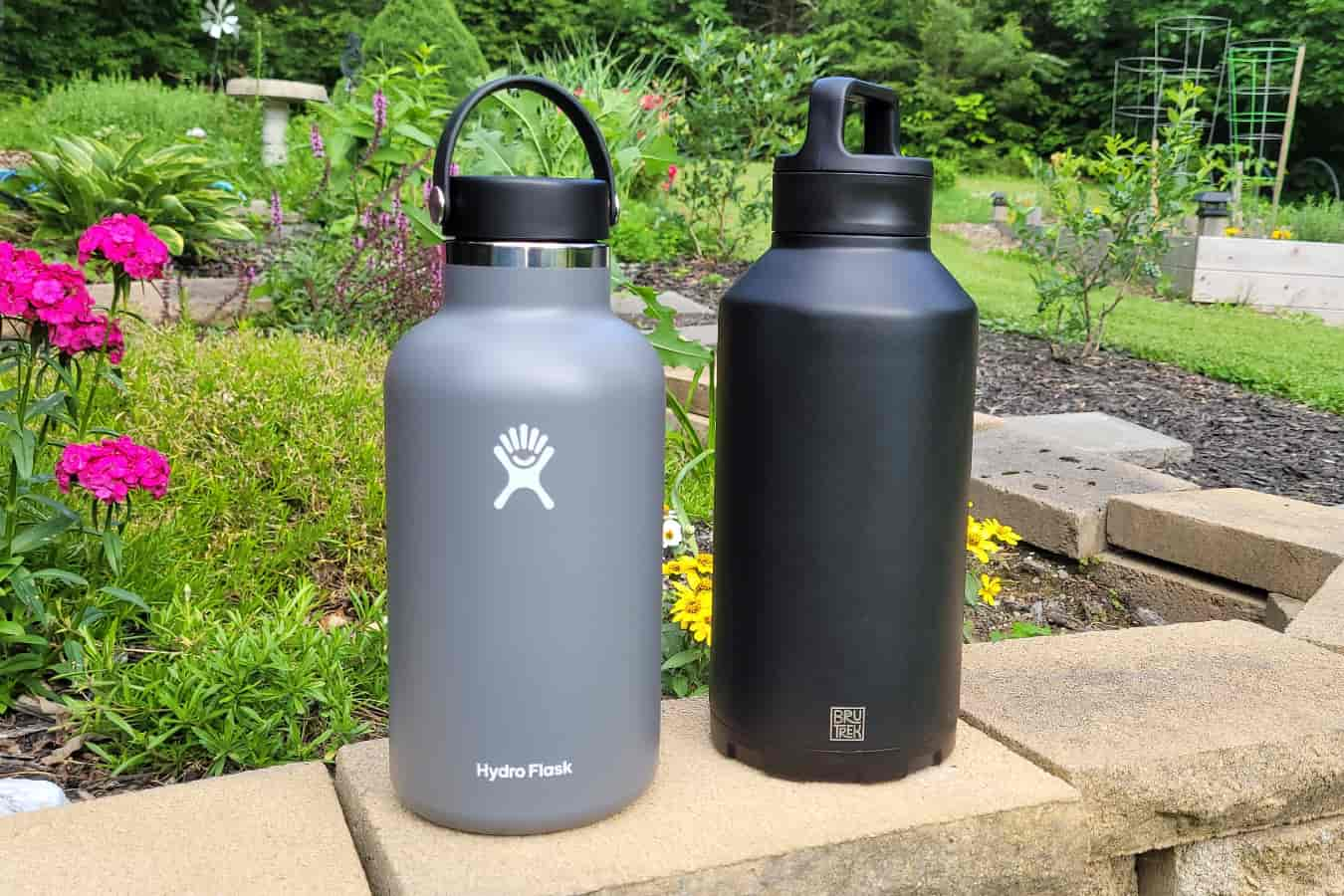Reusable Water Bottles: Drink Responsibly

18, 24 and 32 oz. bottles from Hydro Flask and Brutrekker
Editor’s Note: This is the sixteenth article in our series on fly fishing conservation. This series appears with the support of Epic Fly Rods.
I grew up in an era where proper hydration was an afterthought. As a child, I drank mostly milk. Instant Breakfast, a flavored powder added to milk, was my morning drink. We got a small carton of milk twice a day at school and a glass of milk with meals at home. Each night before bed I had one last indulgence of milk served with Nestle’s Quick chocolate powder.
By the time I hit my teens my drink of choice was soda, or tonic as we called it in New England. In addition to cola, I drank root beer, grape and orange soda, and Mountain Dew. In Maine, they drank Moxie, a concoction dating back to the 1870s that claimed to cure paralysis, nervousness, and “softening of the brain.”
We drank our soda from pop-top bottles pulled from roller-style vending machines, and made-to-order from ice cream parlors or drug stores with counters and round spinning stools. Made-to-order cola could be purchased with a squirt of raspberry (my favorite), strawberry, vanilla, or mint.
Then came non-carbonated beverages which along with soda were referred to as “soft drinks.” Hi-C, Hawaiian Punch, Tahitian Treat, Cactus Cooler, and Lipton Iced Tea were some of the more popular products.
Next up was beer. Pull-tab cans, pop-top bottles, and Giant Imperial Quarts, or GIQs. Schlitz was king and Miller was queen. Budweiser was gaining steam, and Coors with its unique dual round push tabs was popular out west. Carling Black Label, Narragansett, and Pabst Blue Ribbon were in their death throes. There were no craft beers and imported meant Heineken, Becks, or Labatt.
Interestingly, Pabst Blue Ribbon, or PBR as it is now called, experienced an amazing resurgence decades after it fell out of favor as a result of what was one of the most brilliant and effective relabeling campaigns in history. Today, legions of young, educated, and affluent males seek out PBR as a cult-like beer of choice.
Water
The only water I got when I was young came from a school or playground fountain, or a hose on the side of a house. By my mid-teens I rarely if ever drank water. We would go off fishing for days at a time without bringing any water to drink and pull what we needed for cooking and cleaning from a stream or pond
As a result of a slow but steady shift, water is now in vogue in regard to hydration. In fact, bottled water is the number one selling beverage in the United States. Sales eclipsed the previous peak for soft drinks, 15.3 billion gallons, in 2004, and water has outsold the latter every year since 2016 and will continue to do so.
Assuming it comes from a reliable source, water contains no chemicals, preservatives, artificial flavors or colors, salt, sugar, caffeine, and other things that are bad for you. Water also is calorie-free, a plus when you consider that obesity has been linked to asthma, high cholesterol, cancer, diabetes, heart disease, high blood pressure, stroke, etc.
Another issue is dehydration, which is brought on by losing more fluid than you take in. It can sap your energy; make you feel light-headed, nauseous or confused; give you a headache, and in extreme cases cause serious medical problems such as seizures. Drinking lots of water is one of the best ways to avoid dehydration.
Now the Bad News
While water is good for you, it can be bad for the environment. According to Office H20, it takes more than 17 million barrels of oil a year to manufacture disposable water bottles. The process releases 2.5 million tons of carbon dioxide into the atmosphere each year. Per Container Recycling Institute, 86 percent of water bottles are not recycled and end up in landfills or our oceans where they kill an estimated 1.1 million marine animals a year. And plastic bottles take roughly half a century to break down.
Based on what I see in the field, we fly fishers consume a lot of bottled water. I regularly see disposable water bottles on the floors of cars, backs of pickups and SUVs, boats, and in trash bins at boat launches, lodges, and fly shops. To say that disposable water bottles are a common sight throughout the fly fishing world would be fair.

64 oz. bottles from Hydro Flask and BruTrekker
What We Can Do
While I am not suggesting that fly fishers abandon water as a beverage, I do believe that we could and should make some concessions to decrease waste, reduce litter, and otherwise lessen our environmental footprint. With a few adjustments, we could have the best of both worlds—good health and a healthier environment.
While fishing in the backcountry I encounter hikers, backpackers, and campers. To their credit, they have moved away from disposable water bottles in favor of reusable bottles and bladders. Many carry filters so they can safely drink from a natural source found in the field. Due to their numbers, I suspect they have made a notable difference.
Depending on the source, there are between 5 and 10 million fly fishers in the United States. Each influences others through family, friendship, and work. Some influence strangers through blogging, writing, and social media. Others do so through advocacy. In aggregate, this represents a large demographic.
I have migrated away from disposable water bottles. In fact, I rarely buy them, and only when I have no other option. I have an inventory of reusable water bottles in all shapes and sizes, as well as several soft flasks. I use them on the road, in the boat, on the trail, and on the water. I see no negatives and many positives, including cost.
Reusable water bottles come in all shapes, sizes, and colors, and from nearly countless sources: BPA-free plastic, aluminum, stainless steel, double and single wall, insulated and uninsulated, padded and unpadded. And with more styles of caps, lids, and handles than you can imagine.
Manufacturers use terms such as insulated, double-wall, and vacuum-sealed. Double-wall and insulated are used interchangeably. However, if a double-wall bottle is not vacuum sealed the air between the walls can get warm from the outside and work its way inside. Vacuum sealing removes the air making it most efficient in regard to keeping water cold.
Stainless steel is more rugged, durable, healthy, and taste-free than either plastic or aluminum. As a result, it is the best option in regard to reusable water bottles. Nothing keeps water colder longer or holds up as well.
The good news is that many reusable water bottles are made of stainless steel and are vacuum sealed. They keep water cold for hours while in the field, and even in the warmest of places and weather. Often times I still have ice in my bottle days after I fill it. And if you pre-chill your bottle in the refrigerator or freezer before filling it, it will stay cold even longer.
Some of my favorite reusable insulated stainless steel water bottles come from companies such as BruTrekker, Hydro Flask, GSI, Yeti, and Aquamira. They are available in all sizes, shapes, and colors, and with a wide variety of caps, spouts, and other accruements and features. I tested bottles with stated capacities of 18oz, 24oz, 32oz, and 64oz. The 18oz, 24oz, and 32oz models are best for short outings, while the 64oz bottles are for all-day use.
If you are tough on your gear and looking for a more rugged bottle, consider BruTrekker with its dual handle/spout lid and plastic bottom cap which helps prevent denting which can compromise a bottle’s ability to keep water cold. And as is the case with most of their products, Yeti bottles, while a bit more expensive, are rugged as well.
Different bottles of the same size can have notably different physical weights. For example, the 24oz bottles I tested ranged from 10.2oz to 13.5oz for a difference of roughly 25 percent. The 32oz bottles went from 15.4oz 20.0oz, a variance of roughly the same. If weight is a concern, consider the MicroLite series from GSI or Lightweight Wide Mouth Trail series from Hydro Flask.
Another thing to consider is diameter. The 18-20oz bottles I tested ran from 2.75” to 3” wide and fit in most of the vehicle and boat cup holders I tried them in. However, at 3.5” to 3.75” some of the 32oz bottles were too wide to fit in certain cup holders.

Lightweight bottles from GSI and Hydro Flask, and filter bottles from Aquamira
For those who want the option to refill their bottle from the stream while afield or from an unfamiliar source, the Shift bottles from Aquamira allow for the use of an in-line filter. Available in 24oz and 32oz options, you can choose from four different filters that provide varying levels of protection from contaminants: Everyday, Backcountry, Backcountry+, and Worldwide.
During testing, I found that some bottles were not true to spec in regard to capacity. While no bottle fell below the advertised capacity, and the majority were almost exactly what they said they were, the 3 bottles I tested from BruTrekker, 18oz, 32oz, and 64oz, held more water than the website said at 20oz, 36oz, and 68oz respectively.
We fly fishers can and should do more to lessen our environmental footprint and decrease our waste wherever we can. Switching to reusable water bottles, if you haven’t already, is one way you can help protect and preserve the resources we all love. It’s a small price to pay when you consider the negative impacts of disposable water bottles and the positive impacts of getting away from them.











